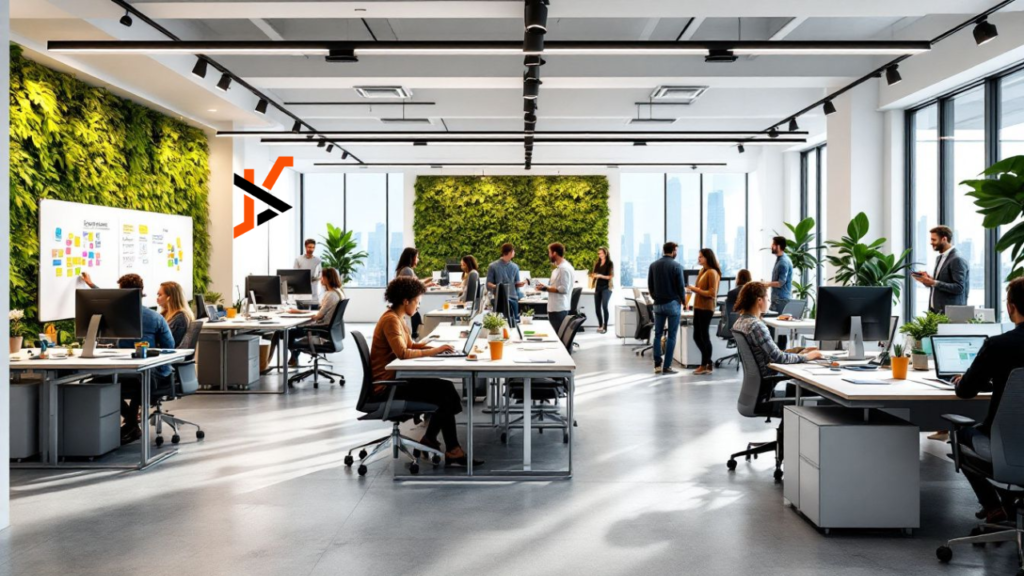What Is an Example of Hot Desking? Top Solutions Explained
Hot desking is a workspace arrangement where employees do not have assigned desks. Instead, they choose any available desk when they arrive at work. This article will show you what is an example of hot desking, highlighting real-world examples from various companies.
Real-World Examples of Hot Desking
Hot desking, a flexible workspace model without assigned seating, has been successfully adopted by several organizations worldwide to enhance collaboration and efficiency.
- Deloitte’s Agile Work Environment:
Deloitte’s Edge building in Amsterdam features 1,000 desks for 2,500 employees, creating a collaborative workspace tailored to projects and team needs. Advanced technology supports remote and hybrid work, boosting productivity and satisfaction. - Macquarie Group’s Sydney Headquarters:
Macquarie Group combines private offices with shared spaces, optimizing space use while fostering flexibility and collaboration. This approach has reduced real estate costs and enhanced productivity. - IBM’s Global Adoption:
IBM has embraced hot desking since the 1990s, using a first-come, first-served system that supports flexible and efficient work across global offices.
How Hot Desking Works in Different Office Environments
Hot desking is a versatile solution that can be adapted to various office environments, from private offices to shared spaces and hybrid workplace models. The main concept involves allocating desks to workers on a rotational basis or as needed, rather than assigning permanent desks, making the UnSpot desk reservation system an effective tool for implementing this strategy.
Here’s how hot desking works in different setups:
Private Offices with Hot Desks
In private offices, hot desking can offer flexibility while maintaining a level of privacy. This setup allows employees to choose where they work each day in a private office, transforming unused areas into collaborative spaces or meeting rooms.
Shared Office Spaces
Shared office spaces, such as coworking environments, often provide access to various amenities like kitchen areas, lounges, and networking opportunities through hot desking arrangements.
Hybrid Workplace Models
Hybrid workplace models blend remote work and hot desking to create a balanced work environment. This integration supports a flexible work approach, accommodating varying schedules and reducing underutilized office space.
Benefits of Hot Desking
Hot desking offers flexibility, cost savings, and improved collaboration while maximizing office space.
- Improved Space Utilization:
Reduces empty desks and increases desk-sharing efficiency, allowing organizations to adapt layouts to changing team needs and potentially lowering real estate costs. - Cost Savings:
Optimizes office expenses by reducing real estate and operational costs, increasing productivity through efficient space use. - Enhanced Employee Collaboration:
Promotes networking and creativity by encouraging interactions across teams, fostering diverse perspectives and a collaborative culture.
Essential Tools and Software for Hot Desking
To implement hot desking effectively, organizations rely on essential tools and software to streamline the process and enhance the experience. Desk booking software plays a critical role, enabling employees to reserve desks and resources with ease, avoiding conflicts, and ensuring efficient utilization. User-friendly interfaces and seamless integrations make these systems indispensable for hot desking success.
Workplace management software further enhances the process by integrating tools for hybrid work environments. It provides comprehensive space scheduling and valuable data insights, helping organizations optimize office layouts and manage resources effectively.
Mobile apps add convenience by allowing employees to view desk availability and make reservations from anywhere. These apps often include communication tools that improve coordination among team members, boosting productivity and fostering smoother workflows in hot desking setups.
Common Challenges and Solutions in Hot Desking
While hot desking offers numerous benefits, it also presents some challenges. Employees may face difficulties in finding available desks, storing personal items, and managing distractions in a hot desking environment.
Let’s explore some common challenges and their solutions.
Managing Personal Items
One of the common challenges in hot desking is managing personal items. Lockers or storage cubes near entrances help employees store their belongings securely during meetings or breaks, eliminating the need for permanent desk space.
Ensuring Privacy and Reducing Noise
Increased noise and reduced privacy are common issues in hot desking environments. Flexible seating arrangements and designated ‘quiet zones’ create focused work environments, helping employees avoid distractions and maintain productivity.
Preventing Desk Conflicts
Conflicts over desk availability can arise in hot desking setups. A first-come, first-served model and clear desk policies minimize conflicts and ensure fair use of available desks.
Monitoring and Improving Hot Desking Practices
To maintain the benefits of hot desking, ongoing monitoring and improvement are essential. Using data analytics to track desk usage and occupancy provides insights for optimizing floor plans and space utilization. Employee feedback is equally important, as it highlights areas for improvement and boosts satisfaction. Regular adjustments based on data and feedback ensure the hot desking setup stays effective and adapts to organizational needs.
Summary
Hot desking offers a flexible and dynamic work environment that can significantly enhance office space utilization, reduce costs, and foster employee collaboration. By exploring real-world examples from companies like Deloitte, Macquarie Group, and IBM, we have seen how hot desking can be effectively implemented to meet various organizational needs. Understanding the benefits, essential tools, and common challenges provides a comprehensive view of how to make hot desking work in different office environments.
Frequently Asked Questions
- What is hot desking?
A flexible workspace model where employees choose any available desk, enhancing collaboration, adaptability, and space efficiency. - What are the benefits of hot desking?
It improves space utilization, reduces costs, and fosters collaboration and productivity in a dynamic work environment. - How are personal items managed in hot desking?
Lockers or storage cubes near entrances provide secure storage for employees’ belongings. - What tools support hot desking?
Desk booking software, workplace management tools, and mobile apps streamline reservations and improve the user experience. - How can challenges be addressed?
Use storage solutions, create quiet zones for privacy, and establish clear desk-use policies to ensure an organized, productive workspace.

